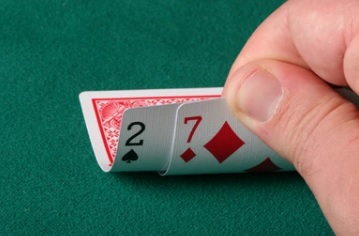
Bluffing is an integral part of Texas Hold’em poker, adding an intriguing layer of psychology and strategic depth to the game. If you want to be a winning poker player, you can’t just play your strong hands and fold your weak hands. Sometimes, you have to win with your trash. But how does one bluff effectively, and just as important, how can you tell when your opponent is bluffing? Let’s delve into the nuances of bluffing and provide you with key insights into managing and reading bluffing frequency.
Bluffing in poker involves making a bet or a raise with a hand that’s not necessarily the best hand, with the intention of making your opponent fold a better hand. Effective bluffing can drastically increase your profits over time, but it’s a delicate balance – bluff too much and you’ll get called, bluff too little and you’ll miss opportunities. Just remember that you need to try to incorporate bluffing and you should always be targeting those opportunities.
Bluffing Strategy
Successful bluffing hinges on your ability to tell a ‘believable story’ with your betting patterns and to adjust your bluffing frequency to the tendencies of your opponents. Here are a few strategic pointers:
Recognize Good Bluffing Opportunities: These usually arise when the board cards suggest you could have a strong hand, and your opponent has shown weakness in their betting. Bluff in late position if there’s only been weakness in front of you. If an Ace or King hits the flop, you can continue the story that you have a strong bet and fire off another bet.
Bluffing Based on Table Image: If you’ve been playing conservatively and suddenly make a big bet, your opponents are more likely to believe you have a strong hand. Be self aware of your image and utilize that. If players have only witness tight play, then bluff them out of pots. If you’ve been caught bluffing a bit too much, tighten up and get them to call your real hands.
Bluff Against One Opponent: The chances of a bluff working decreases with each additional player in the pot. Bluffing is generally more effective against one opponent. Identify and target the weak/tight opponent. Force the opponent to make a tough decision and the wrong decision.
Reading Bluffs
Equally important as bluffing is the ability to read an opponent’s bluff. Here are a few tips:
Player Tendencies and Betting Patterns: The best way to determine a bluff is to stop, think, and analyze your opponent’s betting pattern. What position were they in when they played pre-flop and did they raise or limp or call? What is their range of hands here? Post flop, what was their action, is that believable? If you’ve been observing the opponent’s play, how much do they typically bet if they have the hand and how much on a bluff, can you make an educated guess? Understanding your opponents’ normal behavior is crucial. Players often have ‘tells’ or patterns in their betting behavior that can give clues about their hand. If an opponent who typically plays conservatively suddenly makes a big bet, they might be bluffing. Conversely, an aggressive player who suddenly checks could also be setting a trap.
Board Texture and Betting Story: A player’s actions should be consistent with the board texture and the progression of betting throughout the hand. If the player’s actions don’t align with the ‘story’ they’ve been telling, this could indicate a bluff. For instance, if a player has been playing passively and then suddenly makes a large bet on the river when an inconsequential card comes up, it could be a bluff.
Physical Tells: While harder to quantify, an experienced player may pick up on physical ‘tells’ such as body language, facial expressions, or changes in the opponent’s level of comfort. Players who appear uneasy or suddenly tense up might be bluffing.
Timing Tells: The time taken by players to make a decision can sometimes indicate a bluff. A quick bet can sometimes indicate weakness, as players often try to appear strong when they are weak. A long pause followed by a bet could also indicate a bluff, as the player might be trying to decide if they can make a successful bluff.
Frequency of Bluffing: If you observe a player bluffing often, it is likely they will continue this pattern. This is especially true in low stakes or casual games where players may not adjust their strategies as much. Conversely, if a player rarely bluffs, you should be more inclined to give them credit for a strong hand when they bet big.
Stack Size and Tournament Life: In tournament situations, a player’s stack size and stage of the tournament can influence bluffing. Short-stacked players or those close to the money bubble may be more likely to bluff in an attempt to stay alive in the tournament.
Bluffing Frequency
There isn’t a definitive percentage or frequency of bluffing that can guarantee success in Texas Hold’em poker. The “right” frequency varies greatly depending on numerous factors such as your table image, the players you’re up against, your position at the table, and the specific dynamics of each hand.
However, let’s delve into a more theoretical approach. In terms of bluffing frequency, a commonly cited concept comes from the Game Theory Optimal (GTO) perspective, which introduces the idea of “bluffing to value bet ratio.” According to this principle, the optimal bluffing frequency is determined by the pot odds your opponent is getting.
Here’s a simplified example: If the pot is $100 and you bet $100, your opponent is getting 2:1 pot odds, meaning they need to win at least one out of three times to break even. If you want to make your opponent indifferent to calling, you should ensure that they win exactly one out of three times. Therefore, for every two value bets, you should bluff once. This makes your range consisting of two-thirds value hands and one-third bluffs. You will need to both understand the pot odds of a particular hand, but also try to keep track of how often you’ve bluffed in this scenario.
That said, real poker situations are often more complex and require adjustments based on the specific game situation and your opponents’ tendencies.
Determining the right frequency of bluffing depends on several factors:
Table Dynamics: Identify your opponents. If you’re opponent(s) are calling frequently, bluffing should be minimized. Conversely, if players are folding frequently, increasing your bluffing frequency can be advantageous. You should also bluff more frequently when you’re in position (acting after your opponent), as this gives you more information.
Your Image: If you have a ‘tight’ image, you can bluff more often, as opponents are more likely to believe you have a strong hand. If you have a ‘loose’ image, bluffing should be minimized. Again, be self aware.
Leave a Review
Submit your review | |







